Thunderbolt on Windows Part 2: Intel's DZ77RE-K75 & ASUS' P8Z77-V Premium
by Anand Lal Shimpi on June 3, 2012 2:08 AM EST- Posted in
- Motherboards
- CPUs
- Intel
- Asus
- Thunderbolt
- Ivy Bridge
- Chipsets
Hot Plug & Promise Pegasus, Now Supported Under Windows
For the past year, hot plug of Thunderbolt devices hasn't been supported under Windows—even on a Mac running Boot Camp. Any Thunderbolt device had to be present at POST for it to appear under Windows. In order to have a certified motherboard, BIOS/UEFI workarounds have to be present to allow for Thunderbolt hot plugging under Windows.
With a certified motherboard and a Windows certified Thunderbolt device, hot plug does work as you'd expect it to.
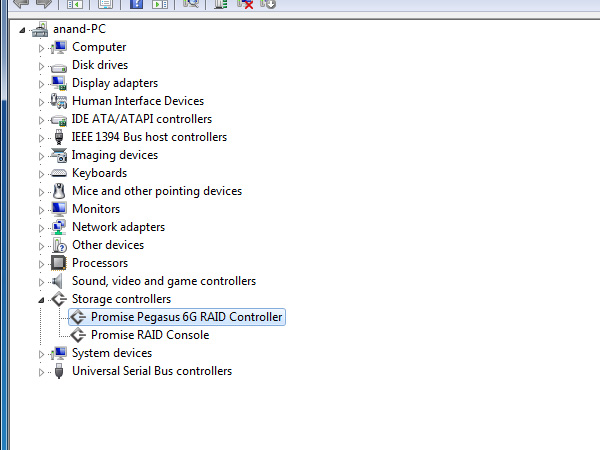
Promise provided us with a beta driver and firmware update that allowed us to use the Pegasus R6 under Windows. Hot plugging worked just fine.
The Promise Pegasus utility under Windows is actually a web based interface, but it provides the same basic functionality as the equivalent OS X application.
What happens if you don't have a certified driver? One of three things can happen. The device will either not work at all, it will compromise stability, or it will work but with some issues. The LaCie Little Big Disk is the perfect example of the last option. I just got a beta certified driver, but prior to receiving it this is what would happen when I plugged it into a running Windows system:
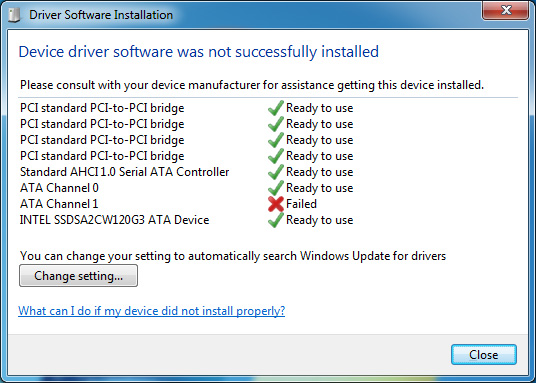
Only one of the two internal SATA channels was detected, meaning only one of the two internal drives was accessible. A reboot fixed this however.
The Elgato Thunderbolt SSD and Seagate's 2.5" GoFlex Thunderbolt adapter both use a different (lower power) SATA controller in order to stay below the 10W limit for a bus powered device (the cable, SATA and pre-Cactus Ridge Thunderbolt controllers combined already eat up around 5W).
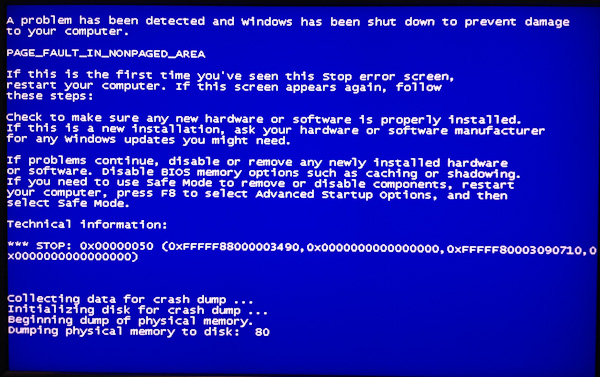
Unfortunately the ASMedia controller in these devices doesn't work well without a certified driver. Simply attaching the Elgato drive to a running Windows PC can cause a BSOD. Neither drive would even show up on either of the motherboards I tested; we'll simply have to wait for a certified driver here.
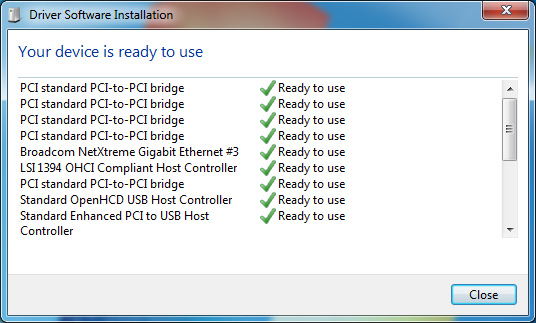
Apple's Thunderbolt Display works but not without a bunch of caveats. First you'll need access to a Mac to extract the drivers for the integrated components in the display (Firewire 800, GigE, etc.). Audio will work but only if you don't have a discrete GPU plugged into the motherboard. Firewire 800 and GigE both work. The integrated USB hub on the other hand basically doesn't work under Windows. Apple doesn't officially support the Thunderbolt Display under Windows and Intel won't certify it without Apple's support so anyone wanting to use a Thunderbolt display will just have to wait for someone else to release a similar product.
Remember the weird audio frame dropping issue I encountered under OS X with the Pegasus and Thunderbolt Display? I also encounter a similar but less severe version of that under Windows. While writing to the Pegasus and playing music through the Thunderbolt Display's speakers I get dropped audio frames, but unlike under OS X the music continues to play and is mostly recognizable—it just sounds like there's a little bit of static in the background. It's interesting that the problem exists under both OSes, but with slightly different behavior.


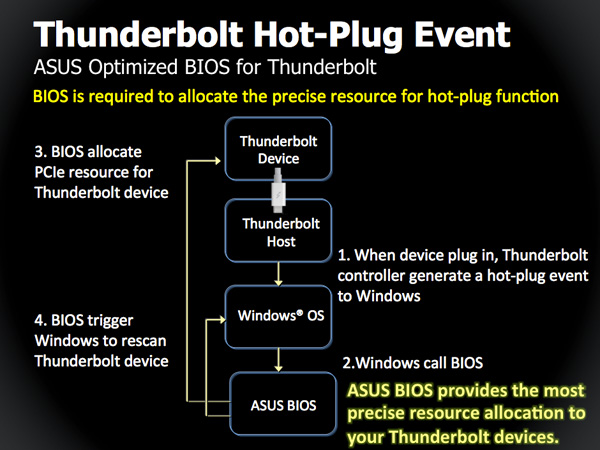
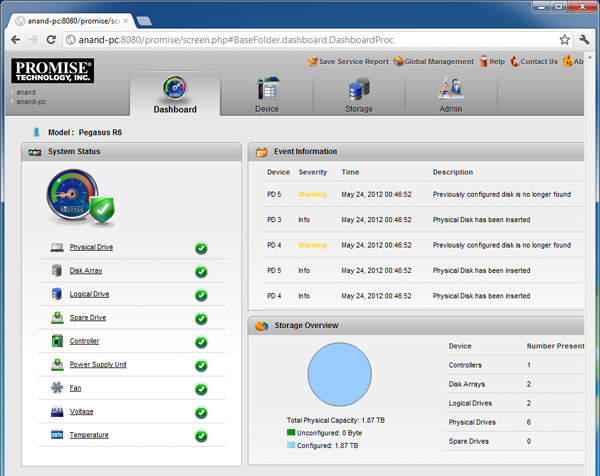














116 Comments
View All Comments
KinslayersLegacy - Sunday, June 3, 2012 - link
"The lowest common capacity was 240GB so the resulting logical RAID-0 drive I built was just under 1GB in size."I assume you meant 1TB in size.
Good article. Can't wait to build a new ASUS workstation & Ivy Bridge so I can use my Thunderbolt drives with my desktop and MacBook Pro interchangeably.
tynopik - Sunday, June 3, 2012 - link
other typo:Apple even build -> built
CeriseCogburn - Monday, June 4, 2012 - link
Great - another proprietary standard that no one can get for a full year, and even after that, only on high end, and redundant anyway, what great innovators you are APPLDrooling Jobs fanatics can buy a thousand dollar hub to reduce cable clutter... ROFL
It runs a monitor... ROFL
It looks like the marketing managers made this one happen - soon they can force hundreds of millions of upgrades so you can plug one gargantuan "Thundar!" the warrior cable in... for... ahh... for you keyboard mouse drive monitor hub...
KitsuneKnight - Tuesday, June 5, 2012 - link
FYI: Thunderbolt was created by Intel. Apple's contribution was the physical port (mDP).CeriseCogburn - Tuesday, June 5, 2012 - link
Who the heck cares, I read about this crap years ago.What does matter is APPL has been a total freaking nazi, and the whole thing is now a year late at least and screwy.
I'm sure you Jobs worshippers are smiling.
CeriseCogburn - Tuesday, June 5, 2012 - link
Also, this is like APPL's recent sole proprietary acquisition of their SDD anusbit tech.The rest of the computing world can go to heck and starve out, so long as Jobs fan boys corner the world market on anything they possibly can, including the entire manufacture base, or let's say a video card, or any thing, IPS panels, whatever...
It's the same sick APPL that costs an arm and a leg as it destroys the world of competition.
God they are sick.
Samus - Wednesday, June 6, 2012 - link
u mad bro?S3anister - Friday, June 8, 2012 - link
he mad, son.SamuraiArtGuy - Tuesday, June 12, 2012 - link
Not like Professional Mac users don't have stuff to bitch about with Apple. The just unveiled "silent" Mac Pro Update was pretty weak.No Thrunderbolt, no USB 3, No eSATA, no Bluetooth 4... and for gods sake, no improved graphics cards? Dude's you're KILLIN' us...
No, seriously. K I L L I N G us...
Can totally grok mad, yo.
DERSS - Sunday, June 10, 2012 - link
Not quite; it is a collaboration: Apple was there in the project from very beginning, and even the name itself was Apple's (they transferred TM to Intel only later). Apple also made cable design (there are tens of elements, including like thirteen active ones), and all the mother board engineering, drivers, BIOS, and testing.Apple was probably the one who brought the idea to Intel. Jobs always wanted to get rid of as many cables and ports as possible and to have one superfast universal port for everything.
The reason why Apple decided not to do it purely alone this time is because Intel's participation would ensure much bigger standard use in the future comparing to what Apple could do alone -- as FireWire interface showed.